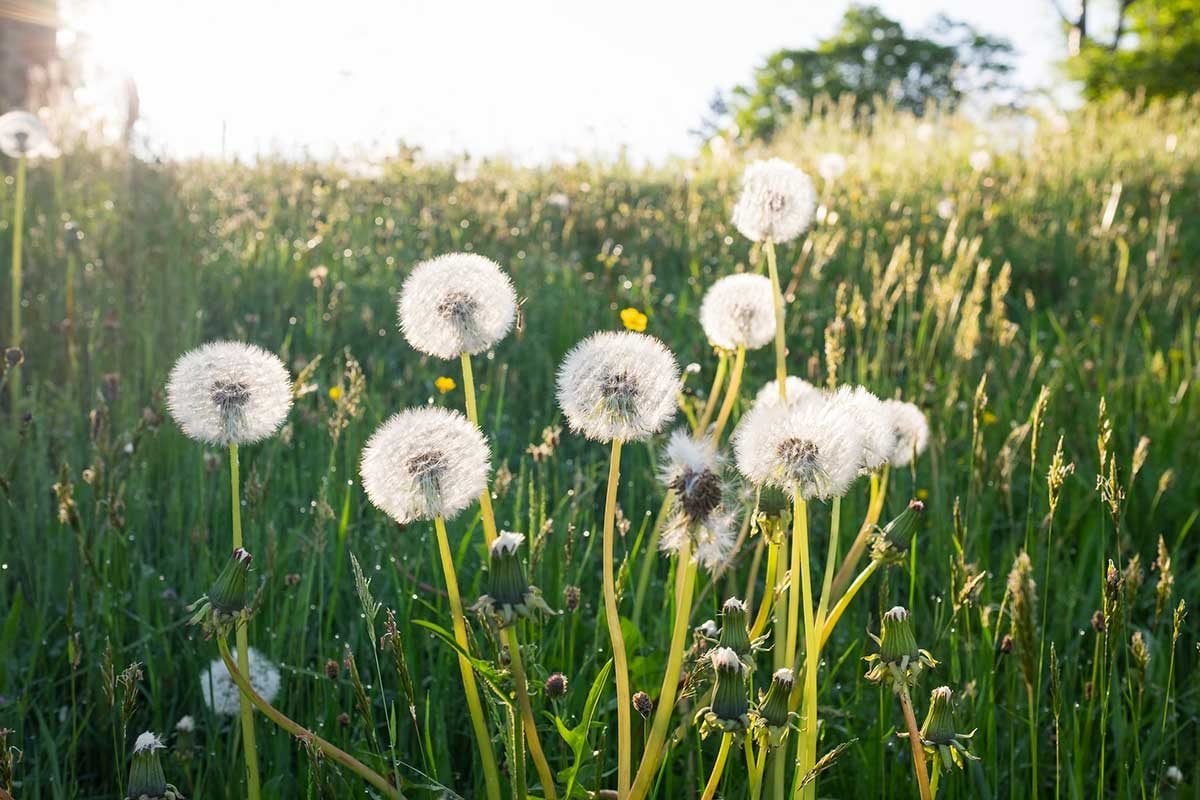What if you could give up the fight and call a truce with dandelions? Here are seven reasons why you might want to make peace with this plant.

7 Reasons You May Not Want to Kill Dandelions in Your Yard

Somewhere, somehow, after the joy of turning our cheeks and chins yellow, chaining them together for flower crowns and making wishes on them faded, we learned that dandelions were actually the scourge of lawns everywhere. While they do tend to be persistent and hardy, punctuating lush green lawns, dandelions have a lot to offer, and we have a few things to unlearn.
Here are seven reasons why we might want to let those hopelessly optimistic, stubborn yellow flowers stick around.
On This Page
Dandelions Are a Pollinator Pot of Gold
Let’s be clear: Are dandelions the BEST pollinator plant? Probably not. According to master gardener and author of Pollinator Friendly Gardening Rhonda Fleming Hayes, the best plants to feed pollinators in early spring are native wildflowers called “ephemerals” because they’re so short-lived. But, she adds, most people don’t have them in their yards. “That said, dandelions are very prevalent and they’re something that pollinators, mostly bees, would utilize as a source of nectar,” says Fleming Hayes.
Gardening Media Group’s Katie Dubow says that not only do dandelions appear in early spring, they appear again in early fall when many garden blooms are flagging. “As more flowers open up later in the spring they will be visited less, so if you plan to remove dandelions from your yard, June or July is a better time to do so. As you get closer to the fall and bees and butterflies are actively foraging in preparation for winter, dandelions will again provide those essential nutrients.”
Dandelions Break Ground
Dubow says dandelions are masters at growing where nothing else can. “They are among the first weeds to colonize disturbed land where other plants won’t grow. Their strong roots can break through the toughest soil and you will often find them growing through concrete,” a fact that frustrates lawn purists, because they absolutely flourish with soil and sun. But here’s where any gardener should find some delight: When dandelions are left to fully develop, their strong taproots can even penetrate hardpan, a layer of compact soil, to extract calcium from the subsoil, making it available to other plants. That means that dandelions improve soil quality, aerate hard-packed soil and help reduce erosion.
Dandelions Provide Phenology Clues
Have you ever tried to get any reliable information on how and when to forage for morel mushrooms? Good luck, as their locations are closely held secrets. But, Fleming Hayes says learning your phenology (the world’s natural cyclical signal) will benefit you greatly. “Start your search [for morels] when dandelions begin to bloom in the spring. . . That’s the sign other things are happening.”
Dandelions Are Edible and Drinkable
First things first: You don’t want to eat anything sprayed with pesticides, so know the history of the ground you’re gathering from. Fleming Hayes suggests foraging for the younger green leaves, which you can sauté with herbs and seasonings or add raw in salads. “It’s a similar spicy, peppery taste, like how you might use arugula in a salad,” she says. Avoid the older leaves, because they can be bitter. She adds that her husband was paid a penny a bloom to collect dandelions for his next-door neighbor, who made them into dandelion wine. You can also fry dandelion heads.
Dandelions Pack Nutritional Punch
Not only can dandelion greens add a little flair to your salad, they are more nutritious than many commonly consumed leafy greens, says Dubow. “They have more vitamin A than spinach, more vitamin C than tomatoes and are a powerhouse of iron, calcium and potassium.”
Because of these nutritional properties, historically, dandelions were used to treat ailments, such as baldness, sores, fever, rotting gums, lethargy, depression and other common symptoms of vitamin deficiencies. “In a time when vitamin pills were a far-off unknown, dandelion was a powerhouse nutrition supplement,” Dubow explains. Even today, herbalists use it as a gentle diuretic that provides nutrients and helps the digestive system function efficiently. (Sidenote: The French call dandelions “pissenlit” which translates to “pee the bed.”)
Dandelions Are … Pretty
It’s OK to admit it: Dandelions look cheery. For many, dandelions’ bright round faces are welcomed at the end of a cold, dark winter with snow-covered landscapes. They are a sign of life returning. “Historically, dandelions were world-famous for their beauty. They were a common and beloved garden flower in Europe and the subject of many poems,” Dubow notes. “Dandelions were likely brought over to America on the Mayflower as a garden plant to serve as a cheerful, sweet reminder of home.”
Dandelions Can Change Mindsets
Starting to think of dandelions as friends can be a catalyst for a whole movement toward more pollinator-friendly environments. By not immediately grabbing the bottle of weed killer, you may very well be allowing plants you consider weeds to grow and provide food and shelter for pollinators. For instance, Fleming Hayes says, milkweed is widely known to help monarch butterflies, but many other butterfly species will only consider one or two plants good hosts (wild violets and nettle being two). “I’m not encouraging dandelions, as much as saying we don’t need to use herbicides or pesticides whenever we see a weed. There are other ways to get rid of weeds, even if they aren’t as easy.”
And one other thing: “It is easy to feel frustrated by these tenacious little plants, but they can teach us an important lesson about survival,” Dubow says. “With roots that can sink deeper throughout the years, they can reach 15 feet underground. They can shove their way through cement and even bloom in barren environments.”




















